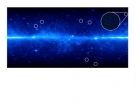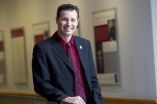(Press-News.org) PROVIDENCE, R.I. -- If dark matter exists in the universe, scientists now have set the strongest limit to date on its mass.
In a paper to be published on Dec. 1 in Physical Review Letters (available in pdf), Brown University assistant professor Savvas Koushiappas and graduate student Alex Geringer-Sameth report that dark matter must have a mass greater than 40 giga-electron volts in dark-matter collisions involving heavy quarks. (The masses of elementary particles are regularly expressed in terms of electron volts.) Using publicly available data collected from an instrument on NASA's Fermi Gamma-ray Space Telescope and a novel statistical approach, the Brown pair constrained the mass of dark matter particles by calculating the rate at which the particles are thought to cancel each other out in galaxies that orbit the Milky Way galaxy.
"What we find is if a particle's mass is less than 40 GeV, then it cannot be the dark matter particle," Koushiappas said.
The observational measurements are important because they cast doubt on recent results from dark matter collaborations that have reported detecting the elusive particle in underground experiments. Those collaborations – DAMA/LIBRA, CoGeNT and CRESST – say they found dark matter with masses ranging from 7 to 12 GeV, less than the limit determined by the Brown physicists.
"If for the sake of argument a dark matter particle's mass is less than 40 GeV, it means the amount of dark matter in the universe today would be so much that the universe would not be expanding at the accelerated rate we observe," Koushiappas said, referring to the 2011 Nobel prize in physics that was awarded for the discovery that the expansion of the universe is accelerating.
Independently, the Fermi-LAT collaboration arrived at similar results, using a different methodology. The Brown and Fermi-LAT collaboration papers will be published in the same issue of Physical Review Letters.
Physicists believe everything that can be seen — planets, stars, galaxies and all else — makes up only 4 percent of the universe. Observations indicate that dark matter accounts for about 23 percent of the universe, while the remaining part is made up of dark energy, the force believed to cause the universe's accelerated expansion. The problem is dark matter and dark energy do not emit electromagnetic radiation like stars and planets; they can be "seen" only through their gravitational effects. Its shadowy profile and its heavy mass are the main reasons why dark matter is suspected to be a weakly interacting massive particle (WIMP), which makes it very difficult to study.
What physicists do know is that when a WIMP and its anti-particle collide in a process known as annihilation, the debris spewed forth is comprised of heavy quarks and leptons. Physicists also know that when a quark and its anti-quark sibling annihilate, they produce a jet of particles that includes photons, or light.
Koushiappas and Geringer-Sameth in essence reversed the annihilation chain reaction. They set their sights on seven dwarf galaxies which observations show are full of dark matter because their stars' motion cannot be fully explained by their mass alone. These dwarf galaxies also are largely bereft of hydrogen gas and other common matter, meaning they offer a blank canvas to better observe dark matter and its effects. "There's a high signal-to-noise ratio. They're clean systems," Koushiappas said.
The pair analyzed gamma ray data collected over the last three years by the Fermi telescope to measure the number of photons in the dwarf galaxies. From the number of photons, the Brown researchers were able to determine the rate of quark production, which, in turn, allowed them to establish constraints on the mass of dark matter particles and the rate at which they annihilate.
"This is the first time that we can exclude generic WIMP particles that could account for the abundance of dark matter in the universe," Koushiappas said.
Geringer-Sameth developed the statistical framework to analyze the data and then applied it to observations of the dwarf galaxies. "This is a very exciting time in the dark matter search, because many experimental tools are finally catching up to long-standing theories about what dark matter actually is," said Geringer-Sameth, from Croton-on-Hudson, N.Y. "We are starting to really put these theories to the test."
INFORMATION:
The National Science Foundation funded the research.
Physicists set strongest limit on mass of dark matter
2011-11-24
ELSE PRESS RELEASES FROM THIS DATE:
Nanoparticle electrode for batteries could make grid-scale power storage feasible
2011-11-24
The sun doesn't always shine and the breeze doesn't always blow and therein lie perhaps the biggest hurdles to making wind and solar power usable on a grand scale. If only there were an efficient, durable, high-power, rechargeable battery we could use to store large quantities of excess power generated on windy or sunny days until we needed it. And as long as we're fantasizing, let's imagine the battery is cheap to build, too.
Now Stanford researchers have developed part of that dream battery, a new electrode that employs crystalline nanoparticles of a copper compound.
In ...
Short waits, long consults keep most patients very happy with their physicians
2011-11-24
ANN ARBOR, Mich.—Patients overall in the United States are very satisfied with their physicians and with treatment they receive in outpatient settings, according to new information which challenges common public perceptions about outpatient medical treatment.
"Particularly surprising is that even a lot of patients who reported average encounters with physicians, such as average national wait times and average physician encounter time, seem to be giving full marks to their physician in terms of visit satisfaction," said Rajesh Balkrishnan, lead study author and associate ...
How drought-tolerant grasses came to be
2011-11-24
Durham, NC — If you eat bread stuffing or grain-fed turkey this Thanksgiving, give thanks to the grasses — a family of plants that includes wheat, oats, corn and rice. Some grasses, such as corn and sugar cane, have evolved a unique way of harvesting energy from the sun that's more efficient in hot, arid conditions. A new grass family tree reveals how this mode of photosynthesis came to be.
The results may one day help scientists develop more drought-tolerant grains, say scientists working at the U. S. National Evolutionary Synthesis Center.
From the grasslands of ...
New Stena Line Superfast Ship Arrives in Loch Ryan Port
2011-11-24
Stena Line's Superfast VII ship has arrived at her new Loch Ryan Port home in Cairnryan in preparation for the opening of the new ferry route between Scotland and Northern Ireland on November 21st.
Superfast VII will be joined by her sister ship Superfast VIII at their new purpose built 27 acre Scottish port that will also encompass a brand new 1,500 square metre passenger and freight terminal. The ships will be the largest ever to sail between Scotland and Northern Ireland.
The new port, new route and new ships are part of a GBP200M rolling investment programme, ...
ONR TechSolutions' rope ascender premieres in 'Modern Marvels' TV episode
2011-11-24
ARLINGTON, Va.— The History Channel will feature an Office of Naval Research (ONR)-sponsored device that could help Sailors and Marines scale walls like Batman during its "Modern Marvels" show Nov. 28.
Funded by ONR's TechSolutions program, the Powered Rope Ascender was originally designed for use by soldiers in urban combat and cave exploration. The handheld climbing tool allows warfighters to ascend and descend vertical surfaces quickly, at a rate of six feet per second.
As ONR's rapid-response science and technology program, TechSolutions funded the project to create ...
Diabetes drug shows promise in reducing risk of cancer
2011-11-24
EAST LANSING, Mich. — An inexpensive drug that treats Type-2 diabetes has been shown to prevent a number of natural and man-made chemicals from stimulating the growth of breast cancer cells, according to a newly published study by a Michigan State University researcher.
The research, led by pediatrics professor James Trosko and colleagues from South Korea's Seoul National University, provides biological evidence for previously reported epidemiological surveys that long-term use of the drug metformin for Type-2 diabetes reduces the risk of diabetes-associated cancers, ...
Scripps Research scientists uncover new role for gene in maintaining steady weight
2011-11-24
JUPITER, FL, November 23, 2011 – Against the backdrop of the growing epidemic of obesity in the United States, scientists from the Florida campus of The Scripps Research Institute have made an important new discovery regarding a specific gene that plays an important role in keeping a steady balance between our food intake and energy expenditure. The study may help scientists better understand the keys to fighting obesity and related disorders such as diabetes.
The study, which was published in the November 25, 2011 print edition of The Journal of Biological Chemistry, ...
Door2Tour.com Announces Popularity of Andre Rieu Tour Packages Among Customers
2011-11-24
Door2Tour.com, the website tour consolidator, has announced that its tour packages to watch Andre Rieu in concert are incredibly popular among the site's customers. Even though Andre Rieu will not be touring the UK until December 2012, the demand for tickets to see him perform is higher than any other product available on the Door2Tour.com website.
To many, Andre Rieu is affectionately known as the 'King Of Waltz' and he is often revered as one of the world's greatest musical entertainers. He has been able to recreate the atmosphere of 19th century Viennese Dance Halls ...
Study finds online marketplaces overplay safeguards and ignore social aspects of transactions
2011-11-24
As Cyber Monday approaches, a new study of e-commerce giants eBay and Amazon challenges a common assumption that trust and risk are always important considerations for buyers in online marketplaces, arguing instead that auction sites may have "over-invested in institutional structures" to reduce buyers' economic risk while ignoring social elements of their transactions.
It has been widely assumed that online auction sites always need to build trust and reduce risk, but a forthcoming article in Information Systems Research counters that it is not necessarily "the higher ...
HSBC Goes Under 4% Interest for 90% LTV Borrowers...and No Fee
2011-11-24
HSBC today (24th Nov 2011) launches its first-ever sub 4% interest rate for mortgage borrowers with a 10% deposit - a 3.84% two-year discount deal with no fee to pay.
During 2011 HSBC has continuously helped first time buyers, and those looking to move on, by offering competitive rates for customers with a relatively small deposit.
In addition to great variable rates, HSBC continues to offer two-year and five-year fixed rates at 85% and 90% LTV fee-free.
Peter Dockar, Head of Mortgages at HSBC, said: 'We are committed to supporting first time buyers and last ...




